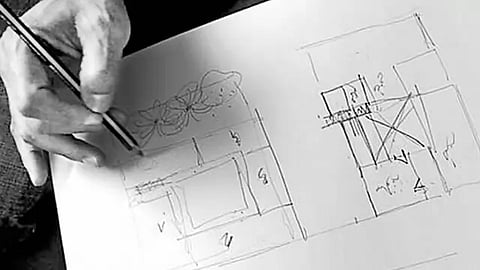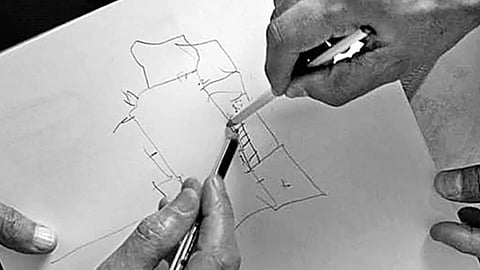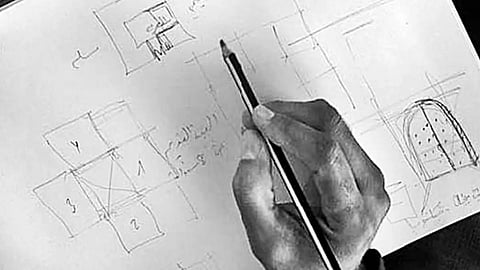I did not grow up with the Indian Partition or the Palestinian Nakbah.The stories related to these events were not my stories. The first time I heard about Partition in detail must have been from my Pakistani friend Aisha when studying at Rijksakademie in 2001, in Amsterdam. She shared tales of her grandparents who, before Partition, had lived in a mansion as big as the former army barracks, which is now the Rijksakademie. The memory of her grandparents seemed to define her in some way, evoking vivid images of tiled floors and old aunts wearing fresh motiya flowers in their ears. In the years I lived in Pakistan (2003–2007), the idea of Partition became more tangible. Stories linked to places I visited. Places gained meaning. The stories made me look at the places differently.
From Partition To Nakbah, Memories Of Home
From childhood memories to national identities, Sophie Ernst’s book HOME explores what the idea of home represents to people who have been forced to leave their homes behind. It also deciphers how artists, filmmakers and writers remembered the places they had left behind during the 1947 India-Pakistan partition and examines the architectural memories of Muslim, Christian and Jewish Arabs living in Palestine and Israel. An excerpt from HOME
I recorded the first conversation for the HOME project in 2006 in Islamabad: Mariam Suhail asked her grandfather to tell us about his childhood home in Old Delhi. He described it in detail and she drew beautifully. Over the course of six years I have approached numerous people, whom I met while teaching in Lahore, on a work trip to India or through a mention of a friend. Some names I found through in-depth research, others quite accidentally. Many people I approached declined out of various reasons, some agreed only after long dialogues, others I met for multiple recordings. In some cases I took the recordings of a conversation to another person who commented on it; we discussed what “home” meant, why places are remembered and how. For the recordings in Palestine and Israel I spent four intense months in the winters of 2008 and 2009 in Ramallah and Tel Aviv. What all conversations had in common was that I was fascinated by the artists’ and writers’ work and was genuinely curious about their ideas on memory and space. The meetings were often intimate and sometimes emotional. I hope to have done justice to the material that I so generously received.
***

Biladi, Biladi!
A conversation between Senan Abdelqader, a Palestinian Israeli architect and Sami Michael, a Mizrachi Israeli writer born in Baghdad, from a chapter titled Biladi, biladi! (My country, My country)
SENAN ABDELQADER/SAMI MICHAEL
(Recorded: Haifa, 2008)
SAMI: Do you want the first house?
SENAN: I’m interested in making
comparisons, when someone moves from one
environment to another, how their memory
“lives” this move. Like you said, today you
are in what would be considered a modern
apartment, in a political situation in Israel
where you can see Akka from here. Maybe if
I try to imagine the home you were born in.
SAMI: The home I was born in is very
old – the same house my grandfather and
grandmother were born in. The most
distinct thing about the house is it’s
traditional, in the sense that many families
lived in it around an open courtyard. I was
a child, so for me the number of people
who lived in the house, not the sense of the
house, was its essence.
SENAN: I want to know from you, when
you imagine the house, how you remember
entering the house.
SAMI: I imagine a street, very tight –
a very tight alley three people couldn’t go
through together. I remember there was a
window and people sitting there, like me and you, could talk. They called this house Im Jeddi , or Be it Michael.
SENAN: OK, we’ve gone into the courtyard –
what do you see? More than one room, or
one room?
SAMI: I see to the right an overhang,
an open room for the courtyard. Like a
sitting room for receiving people, for guests
who would come from abroad. And this is
furnished and has seating. There is one wall
open to the courtyard. From there a door
opens to face the rooms.
SENAN: The rooms are on the right or the left?

SAMI: Give me the paper. This is an alley,
this is the toilet, here, like this. And the
sitting room is here. This is the courtyard
that is open, you enter the courtyard like
this and, like we said, this is toward the
sitting room. From the sitting room there
is another room, as I remember. Here there
are stairs that go down to the basement.
Another family here, and another family here.
SENAN: In this first house there are four
families, yes?
SAMI: Maybe there was another family.
SENAN: So when you were eight years old,
you moved to the second house.
SAMI: The second house was all one
family. It was on proper planned streets like
German planning, all straight [mumbling].
Everyone has their own garden, house
and door.
I remember while riding my bicycle,
singing Biladi Biladi , “My country, my
country” – it was the most beautiful song.
This is my land, my country – I have a
feeling of historical depth, that I have
existed in this place for 2500 years, before
Christianity. This continuity gives historical
depth to my existence here.
SENAN: How was such historical depth
reflected in your feelings?
SAMI: I was rich. I belonged to the
middle class and I had the feeling that my
ancestors had been here even before Islam,
before Christianity, and we will live here
forever. This feeling was deep within me,
I did not see others as enemies or as a threat
to my existence.
SENAN: There’s something here that catches
my attention on the subject of building and
architecture. My education is in architecture
in Germany, but in the end my culture is
originally Arab. That is the environment I
grew up in, even though I was born during
the Israeli period. While growing up I was
affected by buildings around me. My father
added to our building, it was modern in the
Bauhaus style of Tel Aviv. He even used an
Ashkenazi architect at that time. When
I went to Europe to study architecture, all of
the techniques, language and writings were
Western. So I understand your move from
Arab culture, plus your Jewish roots,
religious and otherwise. However, to write in
another language, which in practical terms
is new, you need to create new tools.
SAMI: I pull and take memories with
me in writing. In my writing there are three
strands: the Eastern, Iraqi strand; the
strand of relationships between Arabs and
Jews; and the strand of clashes between
Eastern and Western Jews within Israel.
These three topics are what interest me.
There is no intellectual who can live at the
linguistic and political border between two
nations. Half of me is Arab, and half Israeli.
SENAN: At what point did you go from
writing in Arabic to Hebrew?
SAMI: I stopped writing in Arabic when
I left the Communist Party. I had been
disappointed in the Communists because of
the corruption. I saw that people considered
some of these books Israeli literature, and
Israelis didn’t read them because they
considered them Arab literature. I felt it
was possible to transfer from one language
to another. I created new techniques in
Hebrew, I entered Arabic expressions into
the Hebrew language. It was as if I created
a new language.
SENAN: Where is the Jewish between the two?
SAMI: The Jewish [inaudible] that used
to be with me in Iraq. For me, until today,
[in terms of] my presence, my person and my
thinking, I am living between two worlds.
SENAN: I want to ask you something, I hope
it is not … how do you interpret me as a
Palestinian on the inside [living in Israel]?
SAMI: I always have a feeling that
Eastern Israelis have enemies that are more
obvious than those of Western Israelis. For
you to prove that you are Israeli, you have
to be an enemy of the Arabs. This is the
sickness of all the Israeli settlers and new
arrivals. I never walked down those paths,
that new culture. Tuz z z , to hell with it!
SENAN: I want to get back to the subject of
the house – I still don’t understand. I’m going
to ask you to specify how I can draw. This
salon had its doors to the courtyard?

SAMI: It had two doors, a door from here,
and a door from here.
SENAN: The house you described here –
this is something important, we started with
this question today. You started with the topic
of views – Haifa, seeing Akka. I think that the
issue is not only the way you see things around
you, the issue is your relation with origin.
My childhood was all about neighbourhood –
I lived in Al Taybeh in a housh, I was not aware
of the views then, we did not have any view.
Our house in Al Taybeh was in the old city,
with a court at the centre surrounded by rooms.
The most important thing was how we used
to play as children in this housh.
…but, for you, the first thing you talked
about was the view, you didn’t talk about the
neighbours.
SAMI: I liked the view because it was Iraq.
SENAN: What is important for me to know,
for example, as a father of a seventeen-year-old
son Omar, and Sara, sixteen – I’m always
asked for their identity cards. You passed this
issue quickly by saying that you didn’t
interfere with identities. I can’t imagine –
for me this issue always worried me.
SAMI: I will answer in a simple way. I don’t
care about identities. What are identities?
SENAN: Now, here you are speaking about
something I see in a different way. I’m
talking about a crisis we are living through
nowadays. It consists of the issue of being
open to the world as a whole from one side –
our songs, our culture, our clothes, our food.
You are not talking about these things from
an Arabic point of view, nor as a Hebrew,
nor even an American.
SAMI: Yes – global.
SENAN: But when I look at my sons and
daughters, I notice they are more flexible in
this issue – they don’t have such difficulties.
I’m not talking about the religious side of it,
I know it is a complicated issue by itself.
This is my question for you: have you
never felt that your children were lost, that
their connection to you was broken? How do
you see this?
SAMI: For me as a father, it was
important to teach my children that you are
a human being and any other human is
equal to you. There is no difference between
East or West, Muslim or Christian,
Palestinian or Israeli. See the human side,
not the Arab or the Israeli.
(This appeared in the print as 'Memories Of Home')